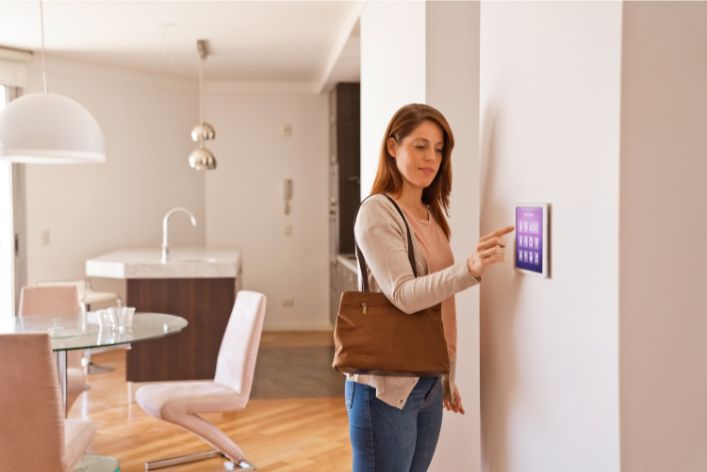Introduction
Definition of Smart Home Technologies
Smart home technologies connect various devices in your home for seamless control and automation.
These devices include smart lights, thermostats, security systems, and home assistants.
They communicate through the internet, allowing you to control them remotely via smartphones or voice commands.
Smart home technologies create an integrated, convenient, and efficient living environment.
Importance of Smart Home Technologies in Modern Living
Smart home technologies significantly impact modern living. They offer:
- Convenience: Control your home’s devices with a simple voice command or a tap on your phone.
- Energy Efficiency: Smart thermostats and lights reduce energy consumption, saving money and protecting the environment.
- Enhanced Security: Smart security systems provide real-time alerts and remote monitoring, ensuring your home’s safety.
- Comfort: Automated systems adjust to your preferences, creating a comfortable living environment.
Purpose of the Blog Post
This blog post aims to:
- Inform: We’ll explain various smart home technologies and how they work.
- Highlight Benefits: We’ll show the advantages of integrating these technologies into your daily life.
- Recommend Products: We’ll suggest popular smart home devices to enhance your living experience.
By the end of this post, you’ll understand smart home technologies better.
You’ll also see how they can improve your home’s efficiency, security, and comfort.
Our goal is to help you make informed decisions about incorporating these technologies into your home.
Smart Lighting
Overview of Smart Lighting
Smart lighting systems revolutionize home lighting by integrating advanced technology and automation.
These systems connect to your home network and allow remote control via smartphones or voice commands.
You can customize lighting to match your preferences, schedule automatic adjustments, and even change colors.
Smart lighting enhances convenience, energy efficiency, and security in your home.
Benefits of Smart Lighting
Smart lighting offers numerous benefits that improve your home environment.
These benefits include energy efficiency, convenience and customization, and enhanced security.
Innovative Tech Solutions, Tailored for You
Our leading tech firm crafts custom software, web & mobile apps, designed with your unique needs in mind. Elevate your business with cutting-edge solutions no one else can offer.
Start Now1. Energy Efficiency
Smart lighting significantly reduces energy consumption.
You can program lights to turn off when not in use, ensuring no energy wastage.
Motion sensors detect movement and adjust lighting accordingly, saving electricity.
You can also dim lights to use less power and extend bulb life.
2. Convenience and Customization
Smart lighting systems provide unparalleled convenience.
Control your lights from anywhere using a smartphone app or voice commands.
You can schedule lights to turn on or off at specific times, adapting to your daily routine.
Customize lighting scenes to match your mood or activity, such as reading, watching movies, or hosting parties.
Color-changing bulbs let you create different atmospheres with ease.
3. Enhanced Security
Smart lighting enhances home security. Program lights to turn on and off while you’re away, giving the impression that someone is home.
Motion-activated lights deter intruders by illuminating when they detect movement.
Integrate smart lights with security systems for coordinated responses to potential threats.
Receive alerts if lights are triggered unexpectedly, ensuring you stay informed about your home’s security status.
Popular Smart Lighting Systems
Several smart lighting systems stand out for their features, reliability, and ease of use.
Three popular options are Philips Hue, LIFX, and Sengled.
1. Philips Hue
Philips Hue is a leading name in smart lighting.
The system offers a wide range of bulbs, light strips, and fixtures.
Control Hue lights through the dedicated app, voice assistants, or smart home hubs.
The system supports extensive customization, including color changes and dynamic lighting effects.
Hue bulbs are energy-efficient and long-lasting, making them a smart investment for any home.
2. LIFX
LIFX smart lighting provides excellent brightness and vibrant colors.
Unlike some systems, LIFX bulbs connect directly to your Wi-Fi, eliminating the need for a hub.
The LIFX app offers easy control and customization options.
You can create schedules, set scenes, and adjust colors effortlessly.
Seamless API Connectivity for Next-Level Integration
Unlock limitless possibilities by connecting your systems with a custom API built to perform flawlessly. Stand apart with our solutions that others simply can’t offer.
Get StartedLIFX bulbs also integrate with various smart home platforms, enhancing their versatility.
With robust features and high-quality performance, LIFX is a top choice for smart lighting enthusiasts.
3. Sengled
Sengled smart lighting combines affordability with advanced features.
Also, Sengled offers a variety of bulbs, including color-changing and tunable white options.
The Sengled Home app allows remote control, scheduling, and customization.
Sengled bulbs can work with or without a hub, providing flexibility in setup.
Additionally, Sengled lights integrate with popular smart home ecosystems, ensuring seamless compatibility.
For those seeking cost-effective smart lighting solutions, Sengled is an excellent option.
Smart lighting enhances energy efficiency, convenience, and security in your home.
Transitioning to Philips Hue, LIFX, or Sengled brings advanced features and customization.
Read: Life with IoT Devices: Revolutionizing Personal and Professional Life

Smart Thermostats
Overview of Smart Thermostats
Smart thermostats bring advanced technology to home heating and cooling.
These devices connect to your Wi-Fi network, allowing remote control through smartphones or voice commands.
They offer features like scheduling, energy usage reports, and learning capabilities.
Smart thermostats make managing your home’s temperature more efficient and convenient.
Benefits of Smart Thermostats
Smart thermostats provide numerous benefits, including energy savings, remote control, and learning capabilities.
These features contribute to a more comfortable and cost-effective home environment.
1. Energy Savings
Smart thermostats optimize your home’s energy use.
They adjust heating and cooling based on your schedule and preferences.
By learning your habits, they avoid unnecessary energy consumption, reducing utility bills.
Many models provide energy reports, helping you track and manage your energy use more effectively.
2. Remote Control
With smart thermostats, you can control your home’s temperature from anywhere.
Use a smartphone app or voice commands to adjust settings remotely.
This feature is particularly useful when you’re away from home and want to ensure a comfortable temperature upon your return.
Transform Business with Custom CRM & ERP Solutions
Elevate your operations with a CRM or ERP tailored for you. Let’s build the perfect solution that others can't replicate—crafted to match your business's needs like no other.
Get StartedRemote control also allows you to make adjustments based on unexpected schedule changes, maximizing convenience.
3. Learning Capabilities
Many smart thermostats learn your preferences over time.
They automatically adjust settings to match your routine without manual input.
This learning capability ensures optimal comfort and efficiency.
Some models even integrate with other smart home devices for enhanced automation, creating a seamless living experience.
Leading Smart Thermostats
Several smart thermostats stand out for their features, reliability, and ease of use.
Three top options are the Nest Learning Thermostat, Ecobee SmartThermostat, and Honeywell Home T9.
1. Nest Learning Thermostat
The Nest Learning Thermostat, developed by Google, is a top choice for smart home enthusiasts.
It learns your schedule and preferences, adjusting temperatures automatically for maximum efficiency.
The Nest app allows remote control, scheduling, and energy usage tracking.
Nest integrates seamlessly with other Google Home devices, providing a cohesive smart home experience.
Its sleek design and intuitive interface make it a popular option for homeowners looking to upgrade their HVAC systems.
2. Ecobee SmartThermostat
The Ecobee SmartThermostat offers advanced features and superior performance.
It includes a built-in Alexa voice assistant, allowing voice control and integration with other smart home devices.
Ecobee provides remote sensors that monitor temperature and occupancy in different rooms, ensuring balanced comfort throughout your home.
The Ecobee app enables remote control, scheduling, and energy reports.
Its compatibility with multiple smart home ecosystems makes it a versatile and powerful choice for smart temperature management.
3. Honeywell Home T9
The Honeywell Home T9 is another leading smart thermostat, known for its reliability and user-friendly features.
It includes remote room sensors that monitor temperature and humidity, adjusting settings for optimal comfort.
The T9 integrates with major smart home platforms, allowing seamless control through various devices.
Its app offers remote control, scheduling, and energy usage insights.
Honeywell’s reputation for quality and innovation ensures the T9 provides dependable performance and efficient energy management.
Smart thermostats enhance your home’s energy efficiency, comfort, and convenience.
Nest Learning Thermostat, Ecobee SmartThermostat, and Honeywell Home T9 stand out with their advanced features and reliability.
Tailored Tech Solutions to Drive Your Business Forward
Maximize your business potential with custom tech strategies. We deliver bespoke solutions that others can’t match, designed to solve your specific challenges with precision and impact.
Contact UsBy integrating a smart thermostat, you can enjoy precise temperature control, lower energy bills, and a more connected home environment.
Upgrade to a smart thermostat to experience the benefits of modern heating and cooling technology.
Smart Security Systems
Overview of Smart Security Systems
Smart security systems integrate advanced technology to protect your home.
These systems connect to your Wi-Fi network, allowing remote monitoring and control through smartphones or voice commands.
They include various components such as cameras, sensors, and alarms, providing comprehensive security coverage.
Smart security systems enhance home safety by offering real-time alerts, remote access, and seamless integration with other smart devices.
Benefits of Smart Security Systems
Smart security systems offer numerous benefits, including enhanced home security, real-time alerts and monitoring, and integration with other smart devices.
1. Enhanced Home Security
Smart security systems provide robust protection for your home.
They include motion sensors, door and window sensors, and security cameras.
These components detect and deter potential intruders, ensuring your home stays secure.
Many systems also feature alarms and sirens that activate during a security breach, further enhancing protection.
2. Real-Time Alerts and Monitoring
With smart security systems, you receive real-time alerts on your smartphone.
These alerts notify you of any unusual activity or security breaches.
You can monitor live video feeds from your security cameras, ensuring you stay informed about your home’s status.
This real-time monitoring allows you to respond quickly to potential threats, providing peace of mind.
3. Integration with Other Smart Devices
Smart security systems integrate seamlessly with other smart home devices.
You can connect them to smart lights, thermostats, and voice assistants for enhanced functionality.
For example, you can program your lights to turn on when the security system detects motion, deterring potential intruders.
Integration with voice assistants like Alexa and Google Assistant allows you to control your security system using voice commands, adding convenience and efficiency.
Top Smart Security Systems
Several smart security systems stand out for their features, reliability, and ease of use.
Three top options are the Ring Alarm Security Kit, SimpliSafe Home Security System, and Arlo Pro 4.
1. Ring Alarm Security Kit
The Ring Alarm Security Kit offers comprehensive home security.
It includes a base station, keypad, contact sensors, motion detectors, and a range extender.
The Ring app allows remote control, monitoring, and alerts.
Ring integrates with other Ring products and Alexa, providing a cohesive smart home experience.
Its easy installation and user-friendly interface make it a popular choice for homeowners seeking reliable security.
2. SimpliSafe Home Security System
The SimpliSafe Home Security System is known for its simplicity and effectiveness.
It includes a base station, keypad, entry sensors, motion sensors, and a panic button.
The SimpliSafe app enables remote control, real-time alerts, and video monitoring.
SimpliSafe works with Alexa and Google Assistant, offering voice control and integration with other smart devices.
Its flexible and affordable plans make it an attractive option for comprehensive home security.
3. Arlo Pro 4
The Arlo Pro 4 provides advanced security camera features.
It offers 2K video resolution, color night vision, and a 160-degree field of view.
The Arlo app allows remote monitoring, alerts, and video storage.
Arlo Pro 4 integrates with Alexa, Google Assistant, and Apple HomeKit, providing seamless control and automation.
Its wireless design and weather-resistant build make it suitable for indoor and outdoor use, ensuring versatile home protection.
Smart security systems enhance home security, offer real-time monitoring, and integrate with other smart devices.
The Ring Alarm Security Kit, SimpliSafe Home Security System, and Arlo Pro 4 stand out for their features and reliability.
By adopting a smart security system, you can enjoy enhanced protection, peace of mind, and a more connected home environment.
Upgrade to a smart security system to experience the benefits of modern home security technology.
Smart Home Assistants
Overview of Smart Home Assistants
Smart home assistants bring convenience and automation to your daily life.
These devices use advanced technology to control your smart home.
They integrate with various smart devices, providing centralized control through voice commands or smartphone apps.
Smart home assistants streamline household tasks, making your home more efficient and user-friendly.
Benefits of Smart Home Assistants
Smart home assistants offer numerous benefits, enhancing your home’s functionality.
Key benefits include voice control of smart devices, access to information and entertainment, and personal assistant features.
1. Voice Control of Smart Devices
Smart home assistants allow you to control your smart devices using voice commands.
You can turn lights on or off, adjust thermostats, and control entertainment systems without lifting a finger.
Voice control simplifies daily tasks, making your home more convenient and efficient.
2. Information and Entertainment
Smart home assistants provide instant access to information and entertainment.
You can ask for weather updates, news briefings, and traffic reports.
They can play music, podcasts, and audiobooks, enhancing your home entertainment experience.
These assistants can also answer questions, provide cooking recipes, and manage your calendar.
3. Personal Assistant Features
Smart home assistants offer a range of personal assistant features.
They can set reminders, create to-do lists, and send notifications.
These features help you stay organized and manage your daily schedule.
Smart assistants can also control smart home routines, automating tasks based on your preferences and habits.
Popular Smart Home Assistants
Several smart home assistants stand out for their features, reliability, and ease of use.
Three popular options are the Amazon Echo (Alexa), Google Nest Hub (Google Assistant), and Apple HomePod (Siri).
1. Amazon Echo (Alexa)
The Amazon Echo, powered by Alexa, is a leading smart home assistant.
Alexa offers extensive voice control capabilities, integrating with numerous smart devices.
The Echo can control lights, thermostats, and security systems. It provides access to music, news, and information.
The Echo supports thousands of Alexa skills, expanding its functionality.
Alexa’s voice recognition and user-friendly interface make it a top choice for smart home automation.
2. Google Nest Hub (Google Assistant)
The Google Nest Hub, powered by Google Assistant, provides a visual interface and voice control.
The Nest Hub integrates seamlessly with other Google services and smart devices.
It displays useful information, such as weather, calendar events, and reminders.
Google Assistant offers robust voice control, handling various commands efficiently.
The Nest Hub can play music, stream videos, and display photos.
Its integration with Google services makes it a versatile and powerful smart home assistant.
3. Apple HomePod (Siri)
The Apple HomePod, powered by Siri, offers high-quality sound and smart home control.
Siri provides voice control for Apple HomeKit devices, ensuring seamless integration with your Apple ecosystem.
The HomePod delivers excellent audio quality, enhancing your music listening experience.
Siri can handle various tasks, such as setting reminders, sending messages, and providing information.
The HomePod’s compatibility with Apple devices makes it a valuable addition to any Apple-centric smart home.
Smart home assistants enhance your home’s convenience, efficiency, and entertainment.
Amazon Echo (Alexa), Google Nest Hub (Google Assistant), and Apple HomePod (Siri) stand out for their features and reliability.
By incorporating a smart home assistant, you can streamline household tasks, access information and entertainment, and enjoy a more connected living environment.
Upgrade to a smart home assistant to experience the benefits of modern home automation technology.
Smart Appliances
Overview of Smart Appliances
Smart appliances integrate advanced technology into everyday household tasks.
These devices connect to your home network, allowing remote control and monitoring.
They use sensors, Wi-Fi connectivity, and artificial intelligence to enhance functionality and convenience.
Smart appliances simplify household chores, making your home more efficient and user-friendly.
Benefits of Smart Appliances
Smart appliances offer numerous benefits, including convenience and automation, energy efficiency, and enhanced functionality.
1. Convenience and Automation
Smart appliances automate routine tasks, saving you time and effort.
You can control them remotely via smartphone apps, ensuring seamless operation.
They often feature self-diagnosing capabilities, alerting you to potential issues before they become major problems.
By automating tasks, smart appliances free up your time for more important activities.
2. Energy Efficiency
Smart appliances optimize energy use, reducing your utility bills.
They adjust their operations based on your usage patterns, ensuring minimal energy wastage.
Many models provide energy consumption reports, helping you monitor and manage your household energy use.
By using energy-efficient smart appliances, you contribute to environmental conservation.
3. Enhanced Functionality
Smart appliances offer enhanced functionality compared to traditional models.
They include advanced features like voice control, remote diagnostics, and integration with other smart home devices.
These features provide greater control and customization, improving your overall home experience.
Enhanced functionality ensures your appliances meet your specific needs and preferences.
Examples of Smart Appliances
Several smart appliances stand out for their features, reliability, and ease of use.
Three notable examples are smart refrigerators (Samsung Family Hub), smart washing machines (LG ThinQ), and smart ovens (June Oven).
1. Smart Refrigerators (Samsung Family Hub)
The Samsung Family Hub smart refrigerator offers a range of advanced features.
It includes a large touch screen that displays calendars, weather, and recipes.
The Family Hub allows you to create shopping lists, stream music, and watch videos.
It features internal cameras that let you view the fridge’s contents remotely.
This helps you keep track of your groceries and avoid unnecessary purchases.
The Family Hub also integrates with other smart devices, providing a comprehensive smart home experience.
2. Smart Washing Machines (LG ThinQ)
The LG ThinQ smart washing machine combines efficiency with convenience.
It offers remote control and monitoring through the LG ThinQ app.
You can start or stop cycles, receive notifications, and troubleshoot issues remotely.
The ThinQ technology uses artificial intelligence to optimize wash settings based on fabric type and load size.
It also integrates with voice assistants like Alexa and Google Assistant, allowing voice control.
The LG ThinQ ensures your laundry is handled efficiently and effectively.
3. Smart Ovens (June Oven)
The June Oven is a versatile smart appliance that enhances your cooking experience.
It includes a built-in camera that recognizes over 100 foods and adjusts cooking settings automatically.
The June Oven offers various cooking modes, including baking, roasting, and air frying.
You can control it through the June app, which provides step-by-step recipes and cooking tips.
The app also allows you to monitor cooking progress remotely.
The June Oven’s advanced features ensure perfectly cooked meals with minimal effort.
Smart appliances bring convenience, energy efficiency, and enhanced functionality to your home.
Samsung Family Hub, LG ThinQ, and June Oven stand out for their innovative features and reliability.
By integrating smart appliances, you can streamline household tasks, reduce energy consumption, and enjoy a more connected living environment.
Upgrade to smart appliances to experience the benefits of modern home technology.
Smart Home Hubs
Overview of Smart Home Hubs
Smart home hubs serve as the central control point for all your smart devices.
They connect various smart devices, enabling unified control through a single app or interface.
Smart home hubs support multiple protocols, such as Wi-Fi, Zigbee, and Z-Wave, ensuring compatibility with a wide range of devices.
By integrating different smart devices into one system, smart home hubs streamline home automation and management.
Benefits of Smart Home Hubs
Smart home hubs offer several key benefits, including centralized control of smart devices, simplified integration and management, and enhanced automation and routines.
1. Centralized Control of Smart Devices
Smart home hubs provide centralized control for all connected devices.
You can manage lights, thermostats, security systems, and more from a single interface.
This eliminates the need for multiple apps, making device management more straightforward and efficient.
Centralized control enhances user experience by providing a cohesive and intuitive system.
2. Simplified Integration and Management
Smart home hubs simplify the integration and management of various smart devices.
They ensure compatibility between different brands and protocols, allowing seamless communication.
This unified system reduces the complexity of setting up and managing multiple devices.
Simplified integration ensures your smart home system operates smoothly and efficiently.
3. Enhanced Automation and Routines
Smart home hubs enable enhanced automation and routines.
You can create customized routines that trigger multiple devices based on specific conditions.
For example, a “Good Morning” routine can turn on lights, adjust the thermostat, and start the coffee maker simultaneously.
Enhanced automation improves convenience and optimizes your smart home environment.
Top Smart Home Hubs
Several smart home hubs stand out for their features, reliability, and ease of use.
Three top options are the Samsung SmartThings Hub, Hubitat Elevation, and Apple HomeKit.
1. Samsung SmartThings Hub
The Samsung SmartThings Hub is a versatile and widely compatible smart home hub.
It supports multiple protocols, including Zigbee and Z-Wave, ensuring broad device compatibility.
The SmartThings app provides centralized control and management of all connected devices.
You can create automation routines, receive alerts, and monitor device status through the app.
The SmartThings Hub integrates with popular voice assistants like Alexa and Google Assistant, enhancing control options.
Its reliability and extensive compatibility make it a top choice for smart home enthusiasts.
2. Hubitat Elevation
The Hubitat Elevation is known for its local processing capabilities, ensuring faster and more reliable automation.
It supports various protocols, including Zigbee, Z-Wave, and Wi-Fi, allowing compatibility with a wide range of devices.
The Hubitat Dashboard provides a customizable interface for managing and monitoring devices.
Hubitat emphasizes privacy and security by processing automation locally rather than relying on cloud services.
Its robust features and emphasis on local control make Hubitat Elevation an excellent option for advanced smart home setups.
3. Apple HomeKit
Apple HomeKit offers seamless integration with Apple’s ecosystem, providing a cohesive smart home experience.
The Home app allows centralized control of all HomeKit-compatible devices.
You can create automation routines and control devices using Siri voice commands.
HomeKit emphasizes security with end-to-end encryption for all device communication.
It integrates with other Apple services, such as iCloud, for remote access and automation.
Apple HomeKit’s user-friendly interface and strong emphasis on privacy make it a popular choice for Apple users.
Smart home hubs enhance the functionality and management of your smart home.
Samsung SmartThings Hub, Hubitat Elevation, and Apple HomeKit stand out for their features and reliability.
By incorporating a smart home hub, you can enjoy centralized control, simplified integration, and enhanced automation.
Upgrade to a smart home hub to experience the full potential of your smart home system.
Smart Plugs and Outlets
Overview of Smart Plugs and Outlets
Smart plugs and outlets transform ordinary appliances into smart devices.
They connect to your home network, allowing remote control and automation.
These devices fit into your existing outlets and integrate with various smart home systems.
Smart plugs and outlets provide an affordable entry point into home automation, enhancing convenience and energy efficiency.
Benefits of Smart Plugs and Outlets
Smart plugs and outlets offer numerous benefits, including energy monitoring and control, remote access, and automation and scheduling.
1. Energy Monitoring and Control
Smart plugs and outlets help you monitor and control energy usage.
They track the power consumption of connected devices, providing real-time data.
This information helps you identify energy-hogging appliances and manage energy use more effectively.
By turning off devices when not in use, you can reduce energy waste and lower utility bills.
2. Remote Access
With smart plugs and outlets, you can control your appliances from anywhere.
Use a smartphone app to turn devices on or off remotely.
This feature is particularly useful when you forget to switch off an appliance before leaving home.
Remote access also allows you to create a more comfortable environment by turning on devices, like heaters or fans, before you arrive.
3. Automation and Scheduling
Smart plugs and outlets enable automation and scheduling of your devices.
You can set timers to turn appliances on or off at specific times.
This feature is ideal for creating daily routines, such as turning on lights in the evening or brewing coffee in the morning.
Automation ensures your devices operate efficiently and according to your schedule, enhancing convenience and energy savings.
Popular Smart Plugs and Outlets
Several smart plugs and outlets stand out for their features, reliability, and ease of use.
Three popular options are the TP-Link Kasa Smart Plug, Wemo Mini Smart Plug, and Amazon Smart Plug.
1. TP-Link Kasa Smart Plug
The TP-Link Kasa Smart Plug offers a user-friendly experience with robust features.
It connects to your Wi-Fi network, eliminating the need for a hub.
The Kasa app allows you to control and monitor your devices remotely.
You can create schedules, set timers, and monitor energy usage through the app.
The Kasa Smart Plug integrates with voice assistants like Alexa and Google Assistant, providing hands-free control.
Its compact design ensures it does not block adjacent outlets, making it a versatile choice for any home.
2. Wemo Mini Smart Plug
The Wemo Mini Smart Plug is known for its simplicity and reliability.
It also connects directly to your Wi-Fi network for easy setup.
The Wemo app provides remote control, scheduling, and automation features.
You can set rules for your devices, ensuring they operate according to your preferences.
Wemo Mini integrates with Alexa, Google Assistant, and Apple HomeKit, offering flexible control options.
Its slim design allows it to fit into any outlet without obstructing other plugs, making it a practical addition to your smart home setup.
3. Amazon Smart Plug
The Amazon Smart Plug offers seamless integration with Alexa, providing a streamlined smart home experience.
It connects to your Wi-Fi network for quick and easy setup.
Use the Alexa app to control your devices remotely, set schedules, and create routines.
The Amazon Smart Plug supports voice control through Alexa, allowing hands-free operation.
Its compact design ensures it fits into any outlet without blocking other plugs, making it a convenient choice for Alexa users.
Smart plugs and outlets enhance energy monitoring, remote access, and automation in your home.
TP-Link Kasa Smart Plug, Wemo Mini Smart Plug, and Amazon Smart Plug stand out for their features and reliability.
By integrating smart plugs and outlets, you can enjoy greater control, convenience, and energy efficiency.
Upgrade to smart plugs and outlets to experience the benefits of modern home automation technology.
Read: Life with AI: Transforming Daily Tasks Using Modern Tools

Smart Home Entertainment Systems
Overview of Smart Home Entertainment Systems
Smart home entertainment systems elevate your audio and video experiences.
These systems integrate advanced technology to provide seamless control and high-quality performance.
They connect to your home network, allowing you to stream content, control devices remotely, and enjoy a more immersive entertainment experience.
Smart home entertainment systems combine convenience with top-tier functionality.
Benefits of Smart Home Entertainment Systems
Smart home entertainment systems offer several benefits, enhancing your viewing and listening experiences, providing voice and app control, and ensuring seamless integration with other smart devices.
1. Enhanced Viewing and Listening Experience
Smart home entertainment systems significantly improve your viewing and listening experience.
High-definition visuals and superior sound quality create an immersive environment.
You can access a wide range of streaming services, ensuring endless entertainment options.
Advanced features like HDR and Dolby Atmos enhance picture and sound quality, providing a cinema-like experience at home.
2. Voice and App Control
Smart home entertainment systems allow you to control your devices using voice commands or smartphone apps.
You can change channels, adjust volume, and switch inputs without using a remote.
Voice assistants like Alexa, Google Assistant, and Siri make control even more convenient.
The accompanying apps provide intuitive interfaces for managing your entertainment setup from anywhere in your home.
3. Seamless Integration with Other Smart Devices
Smart home entertainment systems integrate seamlessly with other smart devices.
You can sync them with smart lights, thermostats, and security systems for a cohesive experience.
For example, you can dim the lights and lower the thermostat when you start a movie.
Integration with other smart devices enhances convenience and creates a unified smart home environment.
Examples of Smart Home Entertainment Systems
Several smart home entertainment systems stand out for their features, reliability, and ease of use.
Three notable examples are Sonos Wireless Speakers, Roku Streaming Stick+, and LG Smart TVs.
1. Sonos Wireless Speakers
Sonos Wireless Speakers provide high-quality audio for your home entertainment system.
They offer rich, room-filling sound and support for multiple streaming services.
You can control Sonos speakers using the Sonos app or voice commands via Alexa or Google Assistant.
They also integrate with other smart home devices, allowing you to create synchronized audio throughout your home.
Sonos speakers are easy to set up and expand, making them a popular choice for home audio enthusiasts.
2. Roku Streaming Stick+
The Roku Streaming Stick+ delivers a comprehensive streaming experience.
It supports 4K, HDR, and HD content, ensuring high-quality visuals.
The Roku remote features voice control, allowing you to search for content, control playback, and adjust settings hands-free.
The Roku app provides additional control options and private listening through your smartphone.
Roku integrates with various smart home platforms, offering a seamless entertainment experience.
Its wide range of channels and user-friendly interface make it a top choice for streaming.
3. LG Smart TVs
LG Smart TVs offer cutting-edge features and superior picture quality.
They support 4K, HDR, and Dolby Vision, delivering stunning visuals.
LG’s webOS platform provides access to numerous streaming services and apps.
You can control LG Smart TVs using the Magic Remote, voice commands, or the LG ThinQ app.
These TVs also integrate with smart home ecosystems, including Alexa, Google Assistant, and Apple HomeKit.
LG Smart TVs’ combination of high performance and smart functionality makes them a leading choice for home entertainment.
Smart home entertainment systems enhance your viewing and listening experiences, provide convenient control, and integrate seamlessly with other smart devices.
Sonos Wireless Speakers, Roku Streaming Stick+, and LG Smart TVs stand out for their features and reliability.
By incorporating smart home entertainment systems, you can enjoy a more immersive, convenient, and connected entertainment environment.
Upgrade to smart home entertainment systems to experience the benefits of modern technology in your home.
Read: How to Start Programming for IoT and Smart Devices
Conclusion
Recap of the Top Smart Home Technologies
Smart home technologies transform everyday living by enhancing convenience, efficiency, and security.
Key technologies include smart lighting, thermostats, security systems, home assistants, appliances, hubs, plugs, outlets, and entertainment systems.
Each technology offers unique benefits, improving various aspects of your home.
The Future of Smart Home Enhancements
The future of smart home enhancements looks promising.
Advancements in artificial intelligence, machine learning, and connectivity will drive further innovation.
Future smart home technologies will offer even greater integration, personalization, and automation.
As these technologies evolve, they will become more intuitive and user-friendly, providing seamless control over all home aspects.
Encouragement to Adopt Smart Home Technologies for Everyday Life
Adopting smart home technologies can significantly improve your daily life.
They provide convenience, energy efficiency, and enhanced security.
Start by integrating a few smart devices and gradually expand your smart home ecosystem.
Experience the benefits of modern technology and create a more connected, efficient, and secure home environment.
Additional Resources
Links to Further Reading
- The Ultimate Guide to Setting Up Your Smart Home
- How to Set Up Your Smart Home: A Beginner’s Guide
- The Best Smart Home Devices of 2024
Before You Go…
Hey, thank you for reading this blog post to the end. I hope it was helpful. Let me tell you a little bit about Nicholas Idoko Technologies.
We help businesses and companies build an online presence by developing web, mobile, desktop, and blockchain applications.
We also help aspiring software developers and programmers learn the skills they need to have a successful career.
Take your first step to becoming a programming expert by joining our Learn To Code academy today!
Be sure to contact us if you need more information or have any questions! We are readily available.











